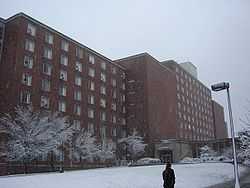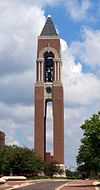LaFollette Complex
| LaFollette Complex | |
|---|---|
 | |
| General information | |
| Type | Dormitory |
| Location |
Ball State University McKinley Ave Muncie, IN 47306 |
| Named for | Dr. Robert LaFollette |
| Completed | 1967 |
| Design and construction | |
| Architect | Walter Scholer & Associates |
LaFollette Complex is the largest residence hall complex on the Ball State University campus in Muncie, Indiana. The complex houses 1,900 men and women in nine halls.[1] They have nine hall directors and the building itself has a net worth of $11 million. The basement of LaFollette houses campus offices, classrooms, computer labs and gym equipment. The basement of LaFollette also has two dining facilities and there is a buffet-style dining hall on the first floor.
LaFollette is named for Dr. Robert LaFollette,[1] who was a social science professor and department head at Ball State University from 1921 to 1961.[2]
Construction
LaFollette Complex was constructed in 1967 with the most recent remodel in 1998.[1] The brick complex consists of four L-shaped eight-story towers and a 10-story tower in the center that houses mainly older and international students.
The elevators in LaFollette and two other of Ball State's taller residence halls – Johnson B and Studebaker East (until Studebaker East's remodel in 2011-2012) – are unusual in that they were extremely early co-ed halls. As such, their elevators serve only two floors: The first floor lobby, and the sixth floor lobby, which duplicates the first floor almost exactly. This served to separate the male and female portions of the dormitory, as the stairs would pass by lobby doors.
Background
This complex was named in honor of Robert R. LaFollette, who was the professor of Social Sciences and head of the department from 1921 until retirement in 1961. He devoted much of his life to the cause of peace. On March 24, 1967, he lost his life in a plane crash on a mountainside north of Da Nang. One thing he was known for was how he had never forgotten a student. Dr. LaFollette could recall the student's name and where they sat in his classes.
The Robert LaFollette Prize in Social Science for the best doctoral thesis has been created in his memory. The Ball State Alumni Association commissioned Nham Chi, a South Vietnamese artist, to paint his portrait.[3]
Halls
Knotts/Edwards
Lucile Knotts had taught at Burris school from 1929 till her retirement in 1953. She continued teaching by lending out a hand at tutoring many different students. She continued tutoring almost till she died in June 1965.
P.D. Edwards was head emeritus of the Department of Mathematics at Ball State University. He retired from Ball State in 1962 after serving thirty-six years on the faculty.
Knotts/Edwards has eight floors for students and every floor is designated to either female or male. Each floor also has a resident assistant(RA)present throughout the day. The first floor holds a main lobby which contains a pool table, ping pong tables, a big screen TV, vending machines and hosts other hall activities. There is also a computer lab, laundry rooms, and study lounges on every floor along with a kitchen accompanying every floor.
Students studying in the Miller College of Business are also a part of the Business Living-Learning Community.
Each room is the traditional rectangular double rooms. The rooms do not have stackable or bunkable furniture. Every room comes equipped with beds, dressers, desks with chairs, and closet space. It also includes an Ethernet outlet and a phone jack. Since the building has been in use for such a long time, the rooms tend to be run-down and dirty.
Brayton/Clevenger
Margaret Brayton was the assistant professor emeritius of Elementary education. She also taught Burris kindergartners and first graders for thirty years. Since her retirement in 1962 she continued to make her home in Muncie, Indiana.
Gola H. Clevenger came to Ball State University in 1924 to teach business education. Two years later he became the admissions director. In 1944 his title was changed to Director of Placement and Senior Counselor in 1950. He attended Indiana University before earning his degree from Ball State where he did additional graduate work. Upon his retirement from Ball State in December 1956, Mr. Clevenger carried the title of emeritus Director of Placement. He died the summer of 1967.
Brayton/Clevenger has eight floors which are designated to female and male. It also has a main lobby on the first floor which houses pool tables, a big screen TV, and other hall activities. It also has a computer lab and has a washer and dryer on every floor.
This hall houses the communications, journalism, and telecommunications majors. If you are involved with any of these you are involved in the Communications Living-Learning Community.
Each room is the traditional rectangular double rooms. The rooms do not have stackable or bunkable furniture. Every room comes equipped with beds, dressers, desks with chairs, a mirror and closet space for each student. It also includes an Ethernet outlet and a phone jack. Since these rooms have been in use for a long time, they have become run-down.
Mysch/Hurst
Lawrence Hurst was the associate professor emeritus of Social Science. He retired from the Ball State faculty in 1950 but he continued to be an active observer of university affairs. He returns to Indiana from his home, in May to spend the summer and fall months attending campus educational, sporting, and social events. He is the author of "61 Years in the School Room" which recounts his early teaching before Ball State and to his years being involved with this University.
Lucia Alice Mysch was the associate professor emeritus of Art. She retired in 1963 after having been a member of Ball State for twenty-nine years. She's known for her work in weaving. She has been exhibited nationally and regionally and had an exhibit of the works of the country's top weavers in the Ball State Art Gallery before she retired. She conducted ten art study tours in the United States and Europe while teaching at Ball State. She was also taking her students into the studios and galleries of the many leading craftsmen of the Nation.
Mysch/Hurst has eight floors which are designated to female and male. It also has a main lobby on the first floor which houses pool tables, a big screen TV, and other hall activities. It also has a computer lab and has a washer and dryer on every floor.
This hall houses some of the International Students who are attending Ball State University.
Each room is the traditional rectangular double rooms. The rooms do have stackable or bunkable furniture. Every room comes equipped with beds, dressers, desks with chairs, and closet space. It also includes an Ethernet outlet and a phone jack.
Woody/Shales
Grace Woody was the associate professor emeritus and coordinator emeritus of Women's Physical Education. She completed thirty-seven years at Ball State, retiring in 1961, she had joined the faculty in 1924.
John M. Shales was part of the Ball State faculty and retired in 1960 after thirty-one years.
Woody/Shales has eight floors which are designated to female and male. It also has a main lobby on the first floor which houses pool tables, a big screen TV, and other hall activities. It also has a computer lab and has a washer and dryer on every floor.
Each room is the traditional rectangular double rooms. The rooms do not have stackable or bunkable furniture. Every room comes equipped with beds, dressers, desks with chairs, and closet space. It also includes an Ethernet outlet and a phone jack.
Shively
Levi S. Shively was the professor emeritus of Mathematics. He had taught for 42 years, 23 of these at Ball State University. He retired in 1951.
Shively is the home to many international students, athletes and those students that are far from home because Shively remains open during holidays and breaks when the other residence halls are closed.
This residence hall has ten floors with a variety of accommodations. There's double rooms, large double rooms, apartments, and suites. Some floors are designated for students who are at least 21 years old.
It also has a main lobby on the first floor which houses pool tables, a big screen TV, and other hall activities. It also has a computer lab and has a washer and dryer on every floor.
Each room is the traditional rectangular double rooms. The rooms do not have stackable or bunkable furniture. Every room comes equipped with beds, dressers, desks with chairs, and closet space. It also includes an Ethernet outlet and a phone jack.
Additional information
A large open field to the east of LaFollette Complex has become known as LaFollette Field. LaFollette Complex overlooks the field that is used for campus events.
References
- ↑ 1.0 1.1 1.2 "LaFollette Complex". Ball State University. Retrieved 5 January 2014.
- ↑ "LaFollette Complex". Ball State University. Retrieved 30 July 2011.
- ↑ Dedication Program. Emens Auditorium. 1968. Print.
External links
- http://cms.bsu.edu/map/buildings/campus/lafollette-complex
- http://cms.bsu.edu/campuslife/housing/halls/map/lafollette
Coordinates: 40°12′24″N 85°24′32″W / 40.2068°N 85.4090°W
